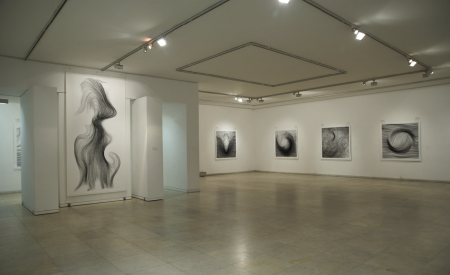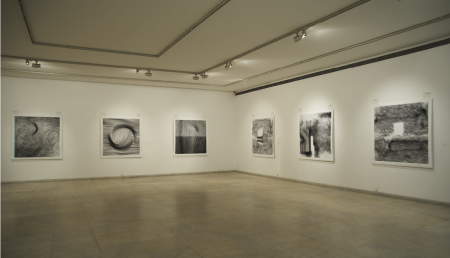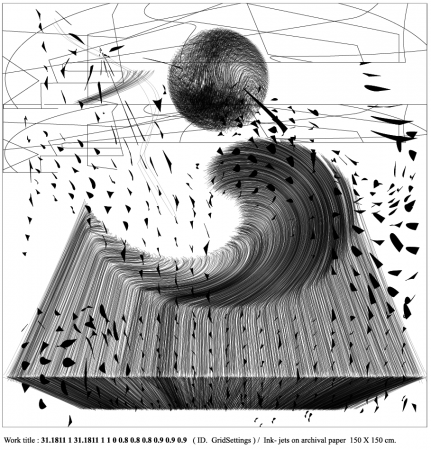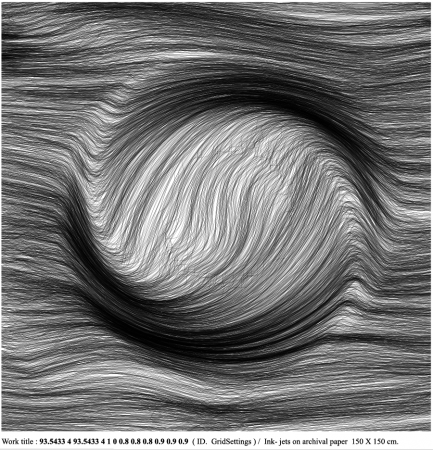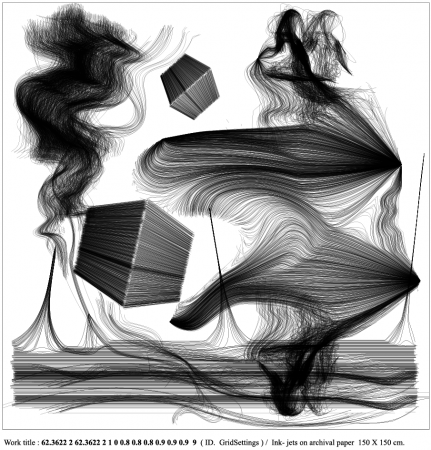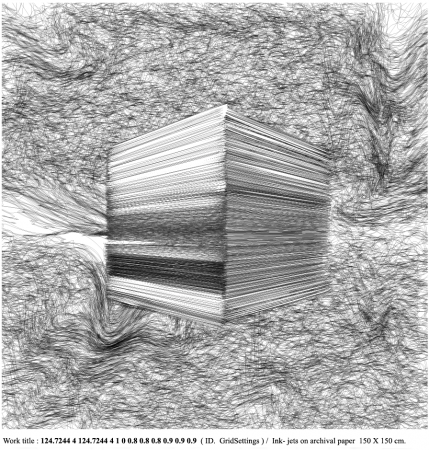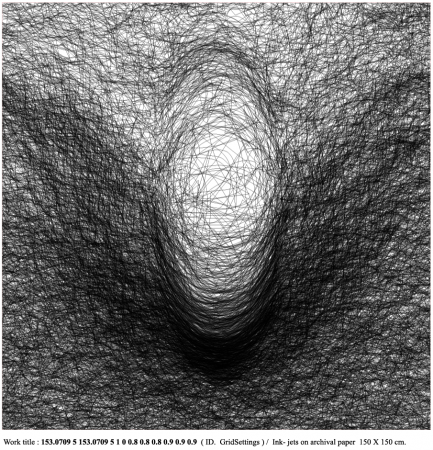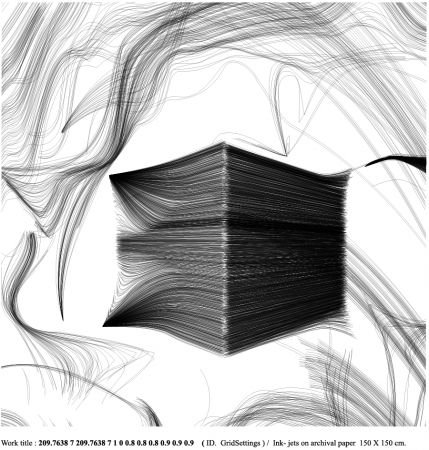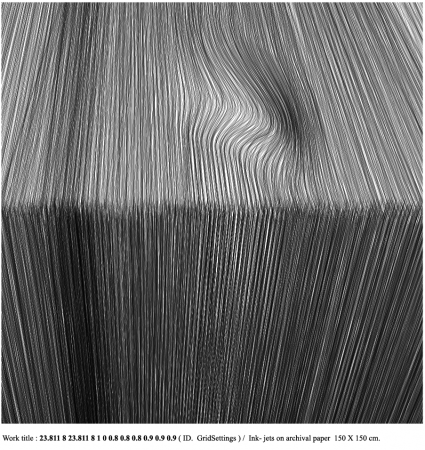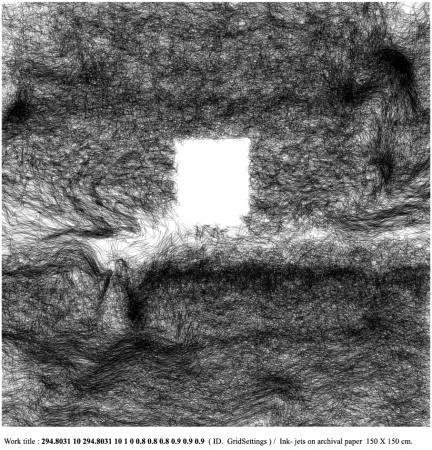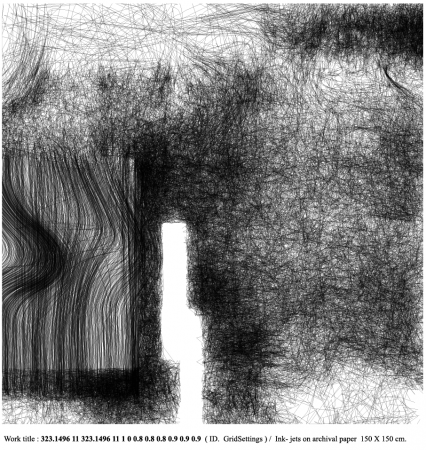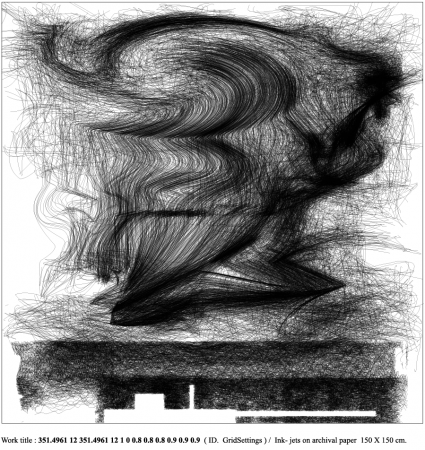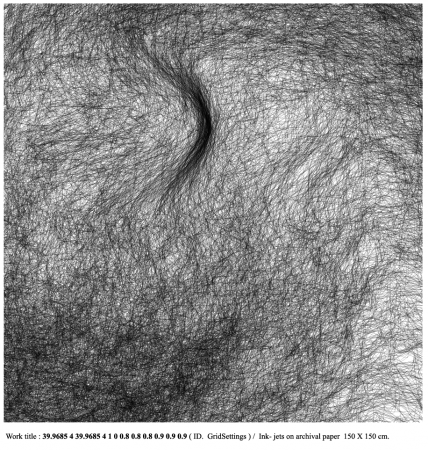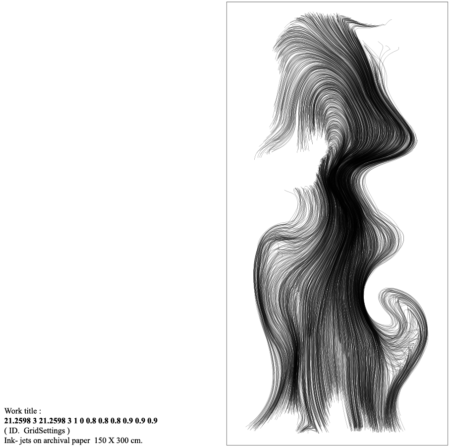|
|
|
‘NOTHING’… IN SEARCH OF FULLNESS
After several years of silence, Kostas-Iraklis Georgiou returns with a
series of works as products of a contemporary methodological and
technological approach to artistic writing, but also as evidence of a
visual approach to philosophical questions. In this series he deals with
one of the most obscure and misunderstood notions of civilisation: the
concept of nothing, of zero, of void – a concept which appears in
different guises in Philosophy, in Science and in Art.
Science these days accepts in general that everything emerged out
of nothing – to be precise, out of the violent eruption of an infinitesimal
bubble of void, assuming, of course, that something which can explode
is really empty. Today, even the meaning of the term ‘void’ has
changed. ‘Nothing’, or ‘zero’ –if that makes it more accessible as a
concept– literally powers the world. Suffice it to remember that
computer bytes are nothing more than endless arrays of zeros and ones.
It is obvious that the title chosen by Kostas Iraklis Georgiou for his
exhibition does not invoke non-existence, and certainly does not imply
a devaluation of the image. It is meant simply to trigger a revision of
the viewer’s gaze; to have the image reactivated by the viewer. This
may be because the artist himself seeks to perceive the concept as a
viewer, having realised the lingual failure (alekton) to understand the
being in relation to the non being.
As we know, such issues have been debated since antiquity. The
Atomists Leucippus and Democritus, who propounded the theory of the
atom, saw the void as a space without matter, whereas the Eleates
believed that what has no presence –the non-being, the void– does not
exist. Aristotle1 explores the differences between the two theories and
then claims that the existence of the void is absurd and the world is a
full and finite space. The concept of the void precludes the idea of
motion. Parmenides comes to build on this theory, placing logic above
experience. According to his theory nothing can arise from a true
nothing, thus making a ‘prophetic’ introduction to space-time.
Yet how feasible is it for us art people to approach or even discuss
such issues? Why would an artist venture to use such a complex notion
as the subject for an exhibition? How can one ‘enlist’ the visual
language to answer philosophical and scientific question? One
explanation could be that where the concepts are inaccessible by
reason, the image may have a place as it can function independently to
some extent. Given the ontological elusiveness of nature, for an artist
the intellect may create patterns. This seems to be the case with Kostas
Iraklis Georgiou.
A pre-existing but well-hidden order of things seems to have served
as the starting point for creation. Consequently, the origin of art les
within that same nothing. Moreover, before starting on a work the
artists often come against a sort of ‘zeroing’ of information and ideas,
as if everything must begin from scratch. It seems that this was how
‘nothing’ became the starting point for the creation of these visual
compositions which, despite their digital underpinnings, retain an
unbreakable bond with the visible world and the traditions of imagery
and handicraft.
Through the hidden logic of his compositions, ‘nothing’ becomes
for the artist a pattern of ignorance and enquiry, a question in perpetuity
or the starting point for further questions, such as ‘after knowledge,
WHAT?’ or ‘after the image, WHAT?’, which make him to turn to the
past as well as to the future.
The specific works seem to draw their inspiration from a universe,
yet it is a mental universe rather than a physical one – which is why the
emphasis in these particular compositions lies on being rather than
signifying.
Yet there is a paradox we must note: the relation between artwork
and tool. The choice of the ‘electronic pencil’ of the computer as a
tool/extension of the hand does more than reflect a desire to adopt
modern media and experiment with technology; it also betrays a
dependence on a traditional way of writing and expression. The
‘electronic pencil’ and the computer are obviously selected mainly for
the advantage afforded by modern technology: that of speed. Suffice it
to think the time it would take to draw by hand the millions of lines in a
single painting. Otherwise, the approach to the work and the process for
the acceptance of the image –by the artist himself, first and foremost–
remain traditional. The intervention of the random element does not
annihilate the aim.
The question that arises at this point is whether the machine has
superseded the artist, subjecting him to its ‘logic’ and painting in his
place? The answer is a categorical ‘no’: The artist has not capitulated to
the medium – he employs it.
The use of a single tool, the stylus, in these works attests to the
painter’s long-standing affection for this medium but also to the
identification between artist and viewer. Perhaps he limits himself to
this archetypal tool of writing in order to turn the viewer’s attention to
the essence of the image he proposes, in the way in which he thinks it
will be accessible to all.
Drawing has played an unwaveringly decisive role in the artistic
career of Kostas Iraklis Georgiou. This can be seen in his illustrations
for short stories in To Vima tis Kyriakis in the ’80s, in his large
portraits of the ’90s and also in his current compositions, which result
from the synergy between traditional drawing and the mathematics of
computers.
In the present works the line intensifies the fragmentation of the
form and ‘obliges’ the viewer to reconstruct it in order to read the
image. In a way, the line assumes the role of what we would call an
elementary particle in Physics.
The ‘assembling’ of the image is left to the individual viewer. The
work unfolds according to each particular gaze and its preconceptions.
The eye of the viewer and the oscillations and dissections of the line
generate relationships, universes and finally an image. And the image is
not just one. In this series of works by Kostas Iraklis Georgiou, given
the subject and our difficulty in forming a concrete perception of the
concept, each part of the image can also function independently as
another work, another universe. The creation of the works adopts the
logic of fractals, a process of successive divisions down to the
minimum indivisible fraction. This minimum unit is ‘translated’ into
writing on the canvas from which the image is derived. The line in
these works demonstrates the hidden relationship between mathematics
and image.
The artist attempts to present the things he carries inside through the
beauty and the harmony of sober science. Ludwig Wittgenstein2 wrote
that the limits of language mean the limits of our world. In the
endeavour of Kostas Iraklis Georgiou it is the combination of sensation
and intellect through a idiom which allows the work to alternate
between a symbol and a wordless image. This potential for a twofold
depiction has been a constant aim throughout his career, and is what
links him to the principles of conceptual art. Also indicative is his
decision to avoid giving descriptive titles to this series of works. His
titles are free of words and the properties they bear, and thus he avoids
the emotive element that language may convey. The numbers with
which he designates the works are like the ID numbers of a
technocratic identity which, in addition to everything else, is in tune
with our present age. Should viewers feel the need for a title with more
information, they are free to furnish one themselves. The artist supplies
the work just with its production data, which reveal how it came to be.
The numbers in the titles are similar to the barcodes on consumer
products.
So let ask the question again: Why would an artist attempt to turn
such a complex concept as that of ‘nothing’ into the subject of an
exhibition? It may be because this question arises every time an artist
finds himself one step before creation: a painter before a blank canvas,
a sculptor before a mass of marble. The artist is called upon to give
shape to the void, to nothing. This void, this ‘nothing’… in search of
fullness, of the reason behind existence, may be the necessary nothing
which starts him on his personal and universal journey.
Katerina Koskina
Art Historian – Museologist
1. Aristotle, Physics
2. L. Wittgenstein, Tractatus Logicophilosophicus, 1922
|

